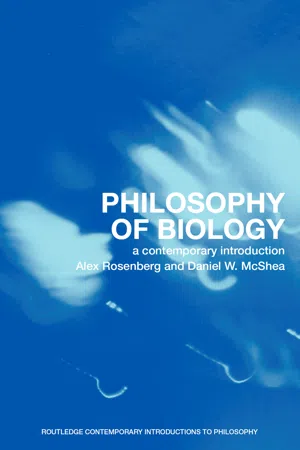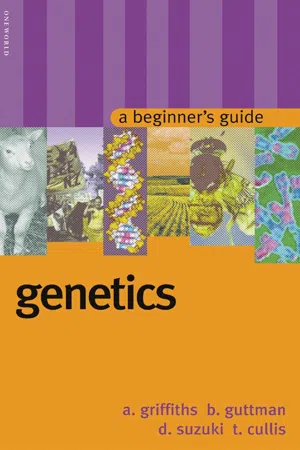Biological Sciences
Mendel's Law of Segregation
Mendel's Law of Segregation states that during the formation of gametes, the two alleles for a gene segregate from each other so that each gamete carries only one allele for each gene. This means that offspring inherit one allele from each parent, leading to genetic diversity in the population.
Written by Perlego with AI-assistance
Related key terms
3 Key excerpts on "Mendel's Law of Segregation"
- eBook - ePub
Philosophy of Biology
A Contemporary Introduction
- Alex Rosenberg, Daniel W. McShea(Authors)
- 2007(Publication Date)
- Routledge(Publisher)
It does not take much more examination than that to conclude that Mendel’s laws are not, after all, really laws at all. Mendel did his famous experiments on pea plants in the mid-nineteenth century. His published results went unnoticed until rediscovered in the early twentieth century and, since then, a major theme of the history of genetics has been the discovery of more and more exceptions to his laws. Luckily for Mendel and for genetics, the traits he first studied did not happen to involve genes located close together on the same chromosomes. Had they been so “linked,” that is lying close together on the same chromosome, they would not have assorted independently. Once linkage was detected, it became clear that the second law is a rough and ready generalization with enormous numbers of exceptions, such as those arising from linkage. As for the law of segregation, geneticists now know cases in which segregation is unequal, in which one of the two alleles is preferentially transmitted to the next generation, the so-called segregation distorter alleles.Of course, just because Mendel’s principles are not laws does not mean that they are not important in biology. What it does mean is that when they are successfully applied in prediction, and when they are not, is a matter to be explained by appeal to other more fundamental regularities. In the case of Mendel’s laws, these will be regularities about meiosis and other details of cell physiology. Is that where the laws are? Somewhere in these lower level processes, is that where we will find the fundamental causal laws of biology that explain Mendelian generalizations and their exceptions?The answer is almost certainly not. Again, the reason goes back to Darwinian theory. For the theory tells us that meiosis, segregation, and assortment are—like other features of organisms such as genes, chromosomes, and sexual reproduction—the result of a long evolutionary history. In the course of that history, natural selection produced adaptation, including both the Mendelian processes themselves—such as meiosis that produces segregation—and other non-Mendelian processes, some of which—such as segregation distorters—take advantage of Mendelian processes. Future environmental changes could modify meiosis further, or even do away with it altogether. Similarly, if natural selection is operating on other worlds circling other suns, we have some reason to suppose that there will be replicators and perhaps also interactors on these worlds but little reason to suppose that they will reproduce by meiosis, or that anything like Earthly sexual physiology will have emerged. The domain of any laws that we discover about sexual processes, or about anything else in biology, could well be quite limited, that is to say limited to a single instance of biology here on Earth and further limited to a particular time range in Earthly evolutionary history. - eBook - ePub
Handbook Of Forensic Genetics: Biodiversity And Heredity In Civil And Criminal Investigation
Biodiversity and Heredity in Civil and Criminal Investigation
- Antonio Amorim, Bruce Budowle(Authors)
- 2016(Publication Date)
- WSPC (EUROPE)(Publisher)
chromosomes, each one predictably with its own but similar mode of transmission. We are now ready to address Mendel’s work with a new focus and an extended framework. It is somewhat surprising that Mendel solved the more complex mode of transmission, i.e. sexual reproduction. We begin by presenting this work and then generalize it to the primary modes of transmission observed in eukaryotes, using the human example, which is a good model for mammalians, and for obvious forensic genetics applications. Other examples will be dealt in other chapters of this book.Mendelian Theory of Inheritance and Modes of Transmission
First of all, Mendel limited his research to cases where observed differences in a specific characteristic(s) between members of a population were clear-cut, i.e. all members could be classified into discrete groups without ambiguity. It is believed that, when studying seed color in his experimental model (Pisum sativum ), Mendel was not ignorant of the differences existing among ‘yellow’ or ‘green’ peas, but he took advantage of the gap between these characteristics, just classifying them into two phenotypic groups. Phenotype will refer to each of the classes into which members of a population can be grouped according to their appearance for a specific characteristic. Mendel hypothesized that, if the observed differences are of a hereditary nature, there should be some place in the cell where the information for the characteristic should be stored. We now know that location — it is a specific region of DNA called a locus (plural: loci) and specifically for the characteristic a gene. He further thought that some difference in content of that information should be responsible for the observable alternative, that is, in modern parlance, that a locus could contain alternative forms (differences in DNA sequence), called alleles. Mendel reasoned further that, in order to avoid the Russian doll paradox, the number of copies of this information should be reduced in each generation of sexual reproduction, so that both parents should generate gametes (female ovules and male spermatozoa) containing only half of the information which, when fusing to form an egg, would reconstruct the amount present in each progenitor. Therefore, each locus can be present in double copy (diploidy), as in the cells of the body of progenitors and in single copy (haploidy), as in gametes. Another term is genotype, which is the specific genetic state of occupancy of a locus in a cell or individual. If the diploid cell possesses two different alleles at a specific locus, it is said to be heterozygous, and if the alleles are identical the genotype is referred to as homozygous. Lastly, Mendel observed that the discrete trait could disappear in one generation and reappear in the next one. Thus, he deduced that these heritable entities were unchanged as they passed form parent to offspring. We now know this observation to be the result of dominant and recessive - eBook - ePub
Genetics
A Beginner's Guide
- Burton Guttman, Anthony Griffiths, David Suzuki, Tara Cullis(Authors)
- 2002(Publication Date)
- Oneworld Publications(Publisher)
What is the probability that you’ve inherited his a allele? Well, the chance that your mother received it from him is ½ and the chance that you received it from her is ½, so the probability is ¼. This is just like flipping a coin twice in a row. The probability is exactly the same that you have received any specific allele from any gene pair in any grandparent. When would two events not be independent? Suppose for some reason that an A egg tends to attract A -bearing sperm and an a egg tends to attract a -bearing sperm. Then in a mating of an Aa male and an Aa female, both producing equal numbers of A and a eggs, the probabilities of getting the various offspring would be skewed from what we usually expect, since fertilization would not occur at random. two or more genes An important application of these concepts of probability is in predicting the results of crosses where we follow two or more genes simultaneously. Mendel performed such experiments, in which he followed characters such as seed color and seed shape together, and they led him to a second important principle, the law of independent assortment : the alleles of two genes assort independently when gametes are being formed. In Chapter 5, we will show how Mendel’s laws follow from the way chromosomes move during cell division. Mendel knew nothing about chromosomes and their behavior in reproduction, and he derived the law of independent assortment strictly from patterns of inheritance, but he was lucky. We shall see later that many genes occur together on the same chromosome and therefore tend to be inherited together, so these are not independent events. However, it just happened that the genes for all the characters that Mendel studied are on different chromosomes (or are so far apart on one chromosome that they are essentially independent)
Learn about this page
Index pages curate the most relevant extracts from our library of academic textbooks. They’ve been created using an in-house natural language model (NLM), each adding context and meaning to key research topics.


